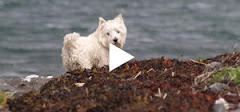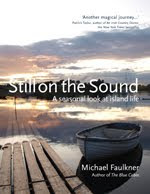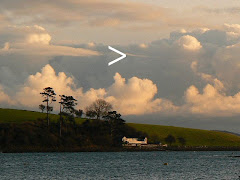
This photograph, courtesy of Manx National Heritage, shows Knockaloe POW camp on the Isle of Man, probably in the winter of 1916/17. It’s interesting to compare it with the photograph from the last post, because the cabin started life as one of these POW huts – if you take off the little extensions at either end, it represents two huts of 15x30 ft, butted end to end.
The camp was in use from 1915 to the end of the First War, and all the huts were auctioned off by the War Department in 1920. The Blue Cabin was shipped over in sections and erected on Islandmore by McCloy’s of Killyleagh, in 1921.
In my research for the book I came across the diary kept by a German Protestant missionary, one Otto Schimming, during his time in the camp. It was published in 1919 unter the title Thirteen Months Behind Barbed Wire. Schimming had been working in the former German colony of Togoland, East Africa, when it was taken over by the British in 1916, and on his arrival at Knockaloe Camp as an enemy alien he wrote:-
“Thin, windy board barracks, no doubt suitable for the Tropics; against the wet, cold climate of the island they offer too little. It seems that the huts were intended for the tropics.” Late of East Africa he adds, with some poignancy, “The windows of the A Huts facing North, in never falls a sunbeam.”
Fortunately, like the B Huts at Knockaloe, The Blue Cabin does get the sun for most of the day, facing just south of west. Otherwise, as regards Schimming’s ‘thin, windy, board barracks’, not much has changed..
The camp was in use from 1915 to the end of the First War, and all the huts were auctioned off by the War Department in 1920. The Blue Cabin was shipped over in sections and erected on Islandmore by McCloy’s of Killyleagh, in 1921.
In my research for the book I came across the diary kept by a German Protestant missionary, one Otto Schimming, during his time in the camp. It was published in 1919 unter the title Thirteen Months Behind Barbed Wire. Schimming had been working in the former German colony of Togoland, East Africa, when it was taken over by the British in 1916, and on his arrival at Knockaloe Camp as an enemy alien he wrote:-
“Thin, windy board barracks, no doubt suitable for the Tropics; against the wet, cold climate of the island they offer too little. It seems that the huts were intended for the tropics.” Late of East Africa he adds, with some poignancy, “The windows of the A Huts facing North, in never falls a sunbeam.”
Fortunately, like the B Huts at Knockaloe, The Blue Cabin does get the sun for most of the day, facing just south of west. Otherwise, as regards Schimming’s ‘thin, windy, board barracks’, not much has changed..














